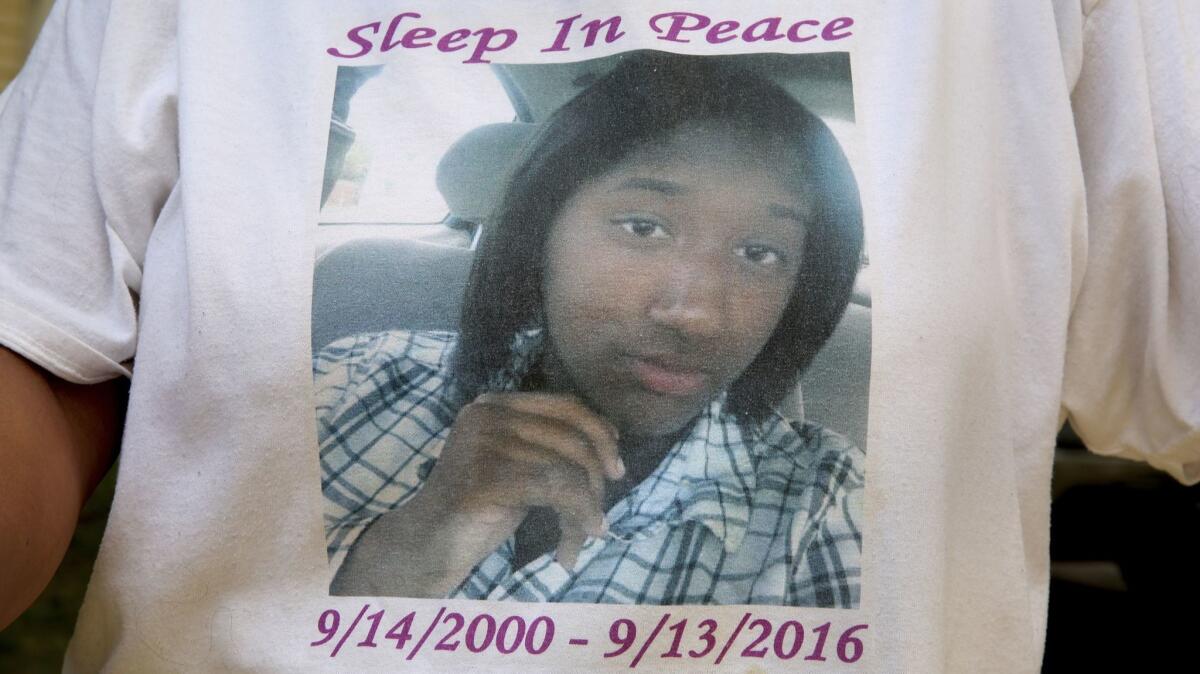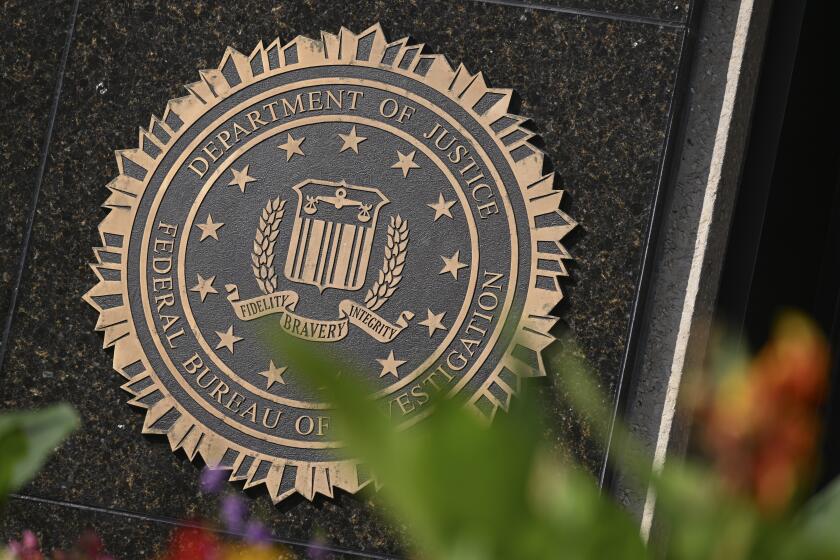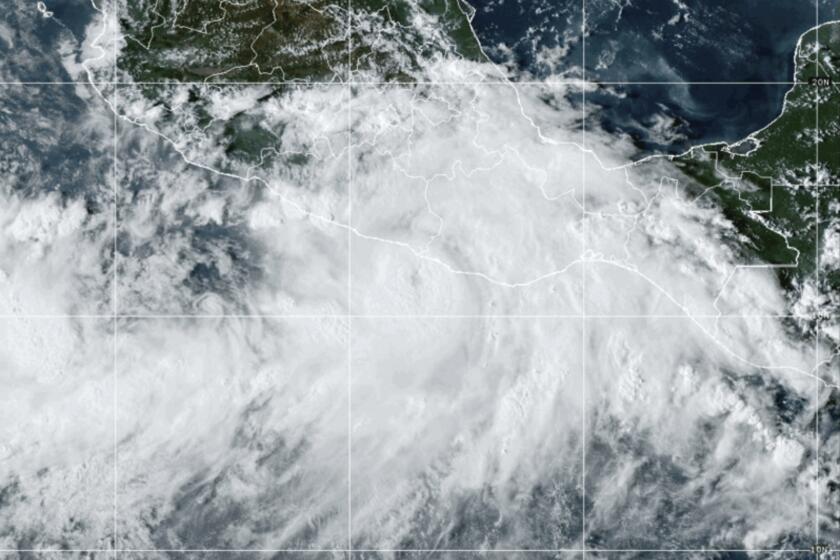Trump heads to Long Island, using brutal MS-13 murders to justify deportations

Trump seizes upon teenagers’ slaying in Long Island, N.Y., to justify the deportation of immigrants.
It was at the corner of a cul-de-sac, in an outwardly placid suburb where children ride bicycles along the sidewalks and families leave baby strollers unlocked on their front lawns.
Nobody would think twice about allowing their teenage daughters to walk home in the evening after doing homework at a friend’s house. So it was extraordinarily shocking when Nisa Mickens, 15, and Kayla Cuevas, 16, were hacked to death with machetes last September.
Their deaths were among a string of 17 Long Island slayings that have been attributed to Mara Salvatrucha, also known as MS-13, an international gang that traces its roots to Salvadoran immigrants in Los Angeles. Now the killings have become Exhibit A for the Trump administration in its crackdown against illegal immigration.
President Trump is due here Friday to address the subject, and Atty. Gen. Jeff Sessions, visiting El Salvador this week, announced Thursday with his Salvadoran counterpart that prosecutors there had filed criminal charges against 113 MS-13 members.
The attention from Washington has elicited a flood of conflicting emotions among people here who are terrified of the gangs, but also fear an immigration crackdown could wrench apart families and the social structure of a community where Latinos have lived comfortably for decades.
“We all know that politicians are going to use whatever they can to help their legacy, but I’ll allow President Trump to use my daughter’s death if it can help eradicate the menace of the gangs from this community,” said Robert Mickens, standing outside his modest yellow-clapboard house a few blocks away from where his daughter, Nisa, was killed. A heart-shaped garden of impatiens planted as a memorial to the girl adorned the front lawn.
Brentwood, which lies about 40 miles east of midtown Manhattan, is 68% Latino, with the older generation running most of the restaurants and other businesses, and the newer immigrants working in manufacturing or service jobs.
Although MS-13 has been known to New York police since the 1990s, it was in the last few years that their brutality started making lurid headlines, especially in the New York tabloids, of which Trump is a devoted reader.

Since Jan. 1, 2016, 17 murders in the area have been attributed to the gang. The most recent occurred April 11, when four young men were allegedly lured into the woods adjoining a park in adjacent Central Islip by female gang members and then killed by machete, the signature MS-13 weapon.
Since the beginning of this year, federal prosecutors in Brooklyn have issued indictments for murder, conspiracy, assault and extortion against 21 alleged MS-13 gang members on Long Island, people referred to in court documents with nicknames like “Satanico” and “Anticriso” and “Cruel.”
“I’m really afraid of the gangs, but I don’t like Trump either,” said Edith Segura, a 57-year-old school bus driver. “He is very racist. He is always trash-talking about Hispanics. He’s looking for votes. I don’t think he is really coming here to help the community.’’
Her daughter, however, was more enthusiastic about Trump’s visit.
“He’s the president and he ought to be able to do something. We really need a SWAT team to get rid of these gangs,’’ said Rommy Aznaran, 36, a businesswoman.
Experts blame the upsurge in violence on the arrival of large numbers of unaccompanied minors from Central America, many of them sent to live with relatives in the U.S. Ironically, gang violence made it difficult for them to attend school in their home countries.
Roughly 8,000 of the minors live on Long Island, and they make up the majority of the suspects arrested for the killings, as well as many of the victims.
Miguel Garcia Moran, a 15-year-old from Ecuador, was killed near the Long Island railroad tracks last year after trying to get out of the gang. “He had been selling marijuana at the high school, but he didn’t want to do it. He was trying to get out,’’ said a family friend, who asked not to be quoted by name because of fear of retaliation. “There is a lot of pressure on these kids.”
Patrick Young, program director of the Central American Refugee Center in Hempstead, also on Long Island, said that the newly arrived teenagers had been vulnerable to recruitment by gangs because many school districts were initially reluctant to admit them, leaving them home alone.
Still, Young believes the hysteria over gang warfare has been exaggerated and manipulated for political gain. Based on police reports, he estimates there are no more than 1,000 MS-13 members on Long Island.
“This is really a cynical exploitation of a tragic situation,” Young said. “Violence from Mara Salvatrucha is largely directed against Latino immigrants and their children. Now President Trump is using it to terrorize the immigrant community.”
In the immigrant community, horror stories abound of migrants being detained by authorities for minor brushes with the law, or being targeted unfairly because of stereotypes. According to Young, one teenager was picked up for decorating his school locker with a Salvadoran flag, which authorities said was a gang symbol.
“They talk about people wearing gang colors. Salvadorians wearing blue is like me wearing green because I’m Irish,” said Young.
Siamara Umana, a lawyer doing pro bono immigration work in Brentwood, says that the immigration crackdown has undermined trust between the immigrant community and police.
“Trump’s rhetoric is making people afraid to come forward,’’ she said. “The stories and the sensationalism doesn’t help either.’’
During the campaign and since, Trump has spoken frequently about gang violence by illegal immigrants.
“You’ve seen the stories about some of these animals,” Trump said this week in Youngstown, Ohio. “They’ll take a young, beautiful girl, 16, 15, and others and they slice them and dice them with a knife.… These are the animals we’ve been protecting for so long.”
Trump didn’t specify which case he was referring to, but his words might have been inspired by the slayings of Nisa Mickens and Kayla Cuevas. The girls had been best friends since elementary school. They were good students who liked music and reading and were crazy about basketball, shooting baskets on the hoop outside Nisa’s house.
“They were so close they used to finish each other’s sentences,” said Elizabeth Alvarado, Nisa’s mother, who wore a T-shirt with her daughter’s image.
Nisa had long dreamed of being a basketball player, but being only 5-foot-4, she had settled on the idea of going into nursing, following the path of her parents, who are both hospital workers. She didn’t speak much Spanish — her mother is Puerto Rican, her father African American — but she had many friends who were immigrants, and she would go out of her way to befriend new students, her parents said.
Kayla — whose parents were from Puerto Rico and the Dominican Republican — was a Spanish-speaker and more often picked on by gang members, her mother testified after the killings.
On Sept. 13, 2016, the night before Nisa’s 16th birthday, the girls had gone to Kayla’s house next to an elementary school to do their homework together.
“She hugged me twice, and said, ‘I love you Mom,’ before she left,’’ recalled Alvarado.
After finishing their homework, the girls left Kayla’s house to visit a friend nearby. Gang members driving by spotted them and went after Kayla, who had reportedly been quarreling with a member of the gang.
“Nisa was in the wrong place at the wrong time. The police told us afterward that it looked like Nisa had tried to protect her friend,’’ said Robert Mickens.
“That’s the kind of person she was. She would stick up for people,’’ Alvarado interjected.
Contemplating the president’s upcoming visit to Brentwood, she said, “If I had a chance to have a conversation with Donald Trump, I would want him to remember what she stood for and what were her values.”
Times staff writers Brian Bennett and Tracy Wilkinson contributed to this report from Washington.
ALSO
Obamacare repeal bill fails in Senate; McCain joins ‘no’ voters
Participant in Cliven Bundy standoff sentenced to 68 years in prison
Michael Bloomberg talks gun control, empowering cities and Trump: ‘I was a manager; he was not’
More to Read
Sign up for Essential California
The most important California stories and recommendations in your inbox every morning.
You may occasionally receive promotional content from the Los Angeles Times.










